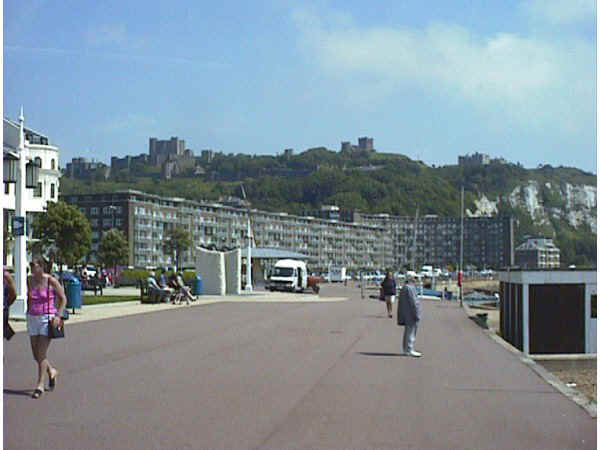| |
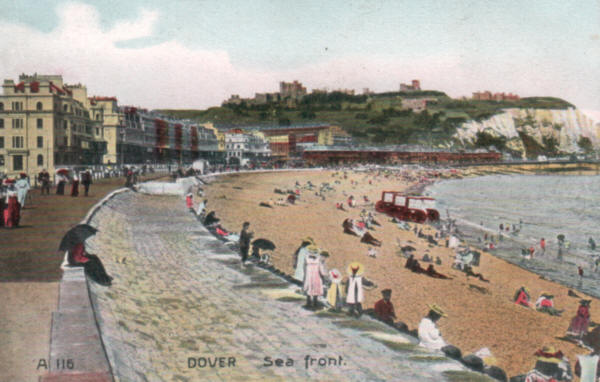
"The Bay Crescent, or Sea Front, as it is usually called, includes the
Esplanade, Waterloo Crescent, Marine Parade, East Cliff, and Athol Terrace.
This is the visitors' quarter of Dover, the objective of all excursionists,
the grand show place where crowds gather to see battleships and liners, to
witness regattas, fireworks, military tattoos, feux de joie, and other
popular demonstrations, which, from time to time, take place on these marine
promenades. When 'stormy winds do blow,' crowds of the braver sort
come here to watch the waves and sea spray dashing 'mountains high'; while,
on peaceful summer evenings, visitors and townfolk promenade under the
dazzling illumination of a thousand electric lights."
(J.B.J.
1907)
The building on the far
left (above) is now the headquarters of Dover Harbour Board. The long,
curved, terrace is the Churchill Hotel (formerly the White Cliffs Hotel),
and the white building beyond this is the home of the Royal Cinque Ports
Yacht Club. The red-brick buildings on the eastern half of the sea
front were demolished after the Second World War and replaced in the 1960s
with a large block of flats.
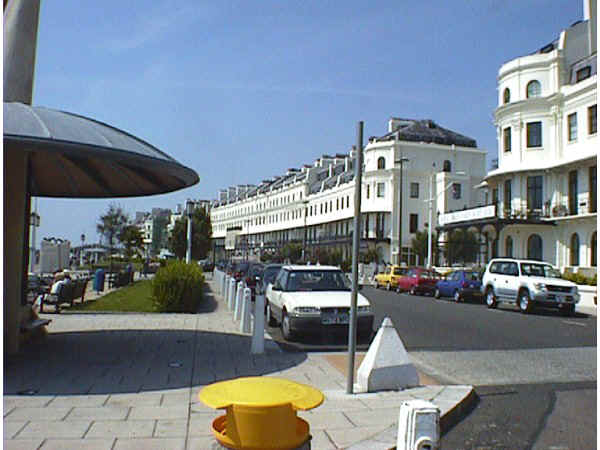
Looking west from the centre of the promenade - the Royal Cinque Ports Yacht Club is
on the right
"Of ancient history there is not much on the Sea Front, for the whole
territory has been filched from Father Neptune, and none of the residences
around it can boast an age of more than fourscore years. At the
beginning of the 19th century, the entire margin of the Bay was unoccupied
by habitations, with the exception of one solitary and peculiar dwelling
under the Castle, partly hewn out of the solid chalk, but mainly consisting
of a series of low buildings, curiously roofed with inverted boats, and
having one part carried up to two stories surmounted by a turret. This
was called Smith's Folly, being built in 1791 by John Smith, father of
Admiral Sir Sydney Smith. Although strange-looking, externally, the
interior was neatly fitted up, forming a pleasant summer residence.
This snug little 'box,' now departed, was the parent fabric of all the
present marine residences which encircle the Dover Bay. The site of
the Sea Front was, prior to 1817, a ridge of shingle and ooze, which began
to accumulate about the year 1500. This great shingle ridge was
Dover's original ropewalk, and the whole area was used, by the authority of
an Act of Parliament as a gathering ground for cobble stones, with which the
Town Commissioners of 1778 paved the streets of Dover."
(J.B.J.
1907)
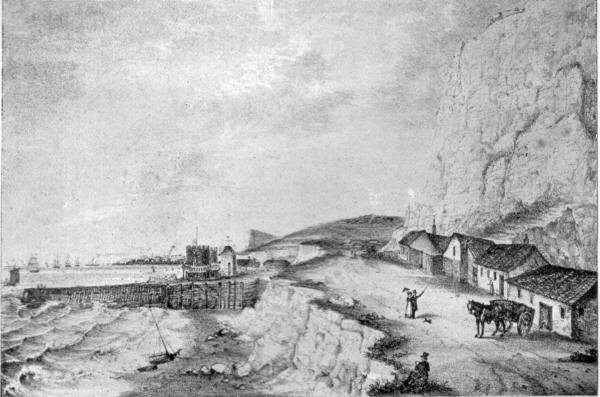
East Cliff in 1800, showing Smith's Folly
"The Marine Parade was built and completed in 1820, when Liverpool
Terrace partially lost its sea view. The houses on the Esplanade, at
the western horn of the Bay, were commenced in 1833; and Waterloo Crescent,
the finest elevation of all, in 1834." (J.B.J.
1907)
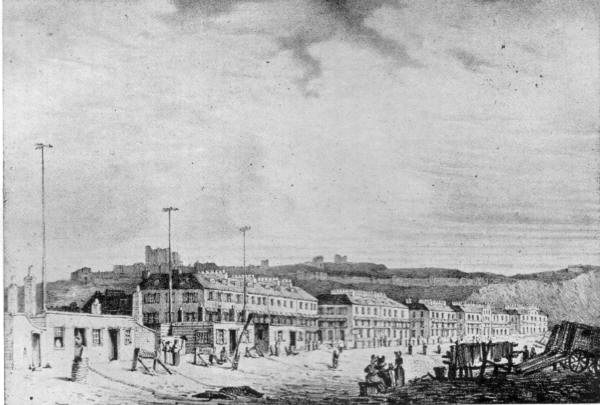
Marine Parade and Bathing Establishment, 1830. Compare this with
the pictures below and at the bottom of the page.
"The fashion of sea bathing and spending a certain period of the year at
the seaside, having set in, lodgings were in great demand, and the whole of
the houses round the Sea Front were soon completed. Bathing machines
were introduced, and two bathing establishments were located in the centre
of the Bay, between Waterloo Crescent and the Marine Parade. The
tenant in possession of the one establishment, in 1839, was Mrs. Ann Dudson,
but, in 1840, it was sold to Mr. James Brett, grocer, of King Street.
The other establishment was carried on by Mr. Cullen Marsh, and he was in
possession of the original bathing establishment in 1877, until the ground
was cleared for the formation of the Granville Gardens. The new
bathing establishment was founded at East Cliff, by Mr. W. J. Adcock, Mr.
Cullen Marsh being the first lessee. Dover is now well off for marine
baths, swimming baths, private baths, and bathing machines, the whole of
which are under municipal ownership." (J.B.J. 1907)
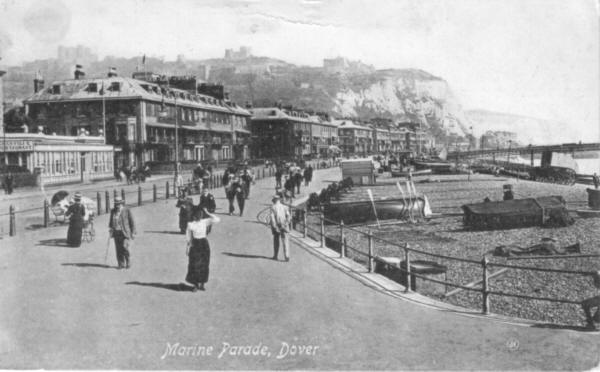
This picture shows the Granville
Restaurant on the left, with the houses of Marine Parade behind. The
Promenade Pier can be seen on the right and, in front of it, a bathing
machine drawn up on the beach. There are also a number of small boats
on the beach.
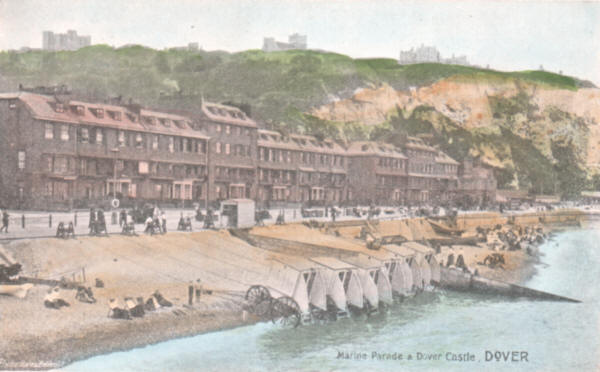
This view is taken from the Promenade
Pier looking east towards the castle. It clearly shows the bathing
machines attached to winches at the top of the beach to enable them to be
moved up and down with the tide or removed for safety during bad weather.
Notice the ladies in deckchairs taking the sun and sea air.
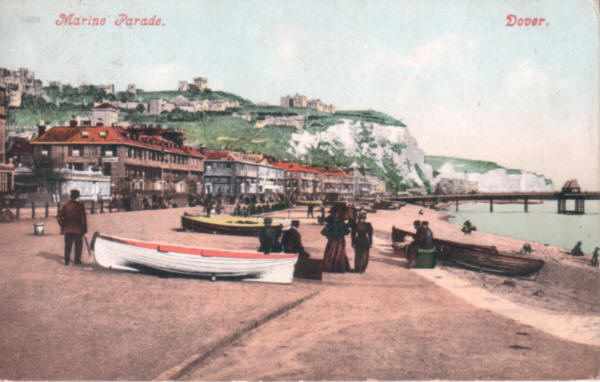
The tower of the Burlington Hotel can
be seen above the houses in this picture, taken from a card posted on the
6th April 1912. "Dear Mummy ... Yesterday morning (we) went as far
as the coal-mine."
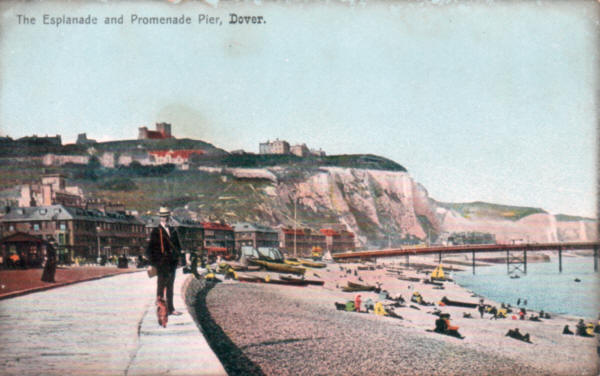
The Granville Restaurant is missing
from this picture. The bathing machines have been drawn right up to
the top of the beach. The top of the Burlington Hotel can be seen
quite clearly above the roof of the first block of houses on the Esplanade.
|
|
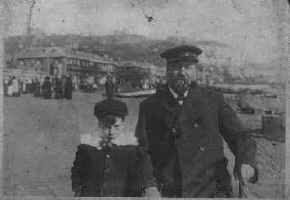
This photograph of my Great Grandfather was taken around 1900
Much has changed on Dover seafront in the last 100 years, partly due to the efforts of
Hitler, partly to the local Council, but to a large extent due to the port expansion at
both ends of the harbour.
Gone is the old Promenade Pier, the skating rink (once managed by the small boy in the
picture above), the drill hall, and the sea-plane shed. No more do the motor boats
offer half-hour trips round the bay from the beach. Gone are the trains that used to
puff along the front from the Eastern Docks to join the main line by Strond Street.
Gone, too, are most of the buildings in the picture above, replaced by the gigantic
block of flats seen below.
Where once we walked along the North Pier to watch the ships going in and out of the
basin, now stands the car park for the hoverport.
Gone is the train ferry dock, where the night sleeper from London to Paris would be
loaded on to the ship for the short sea crossing.
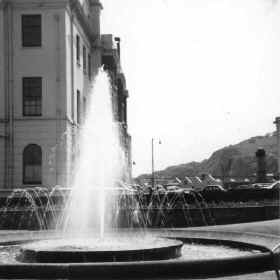
Sea-front fountain - 1960s
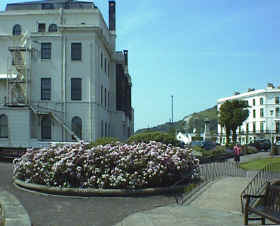
Sea-front fountain - now a flower bed
|
|

This photograph of me was taken in 1950
Gone is the aerial ropeway carrying coal from Tilmanstone Colliery to the bunkers on the
Eastern Arm. Gone, too, are the oil terminal, the pen factory and the submarine
pens, replaced with an ever-growing car-ferry terminal.
Where once we saw rows of ferries alongside the Admiralty Pier loading for Calais,
Boulogne and Oostende, now we see cruise liners sailing to the Norwegian fjords and the
Mediterranean.
Much of this change has taken place in my lifetime. I suppose that's progress,
but I still miss many of the old sights and sounds of the Dover of my youth.

This fountain was in ftont of the Gateway flats
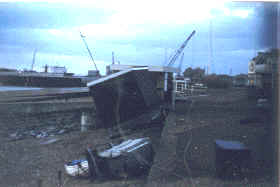
After the storm of '78
|














